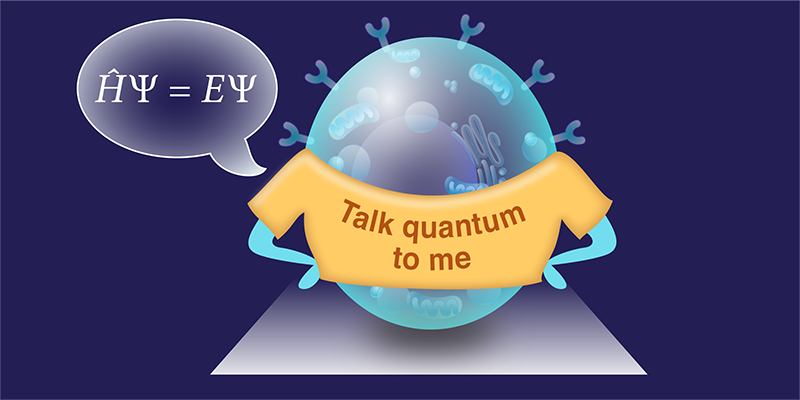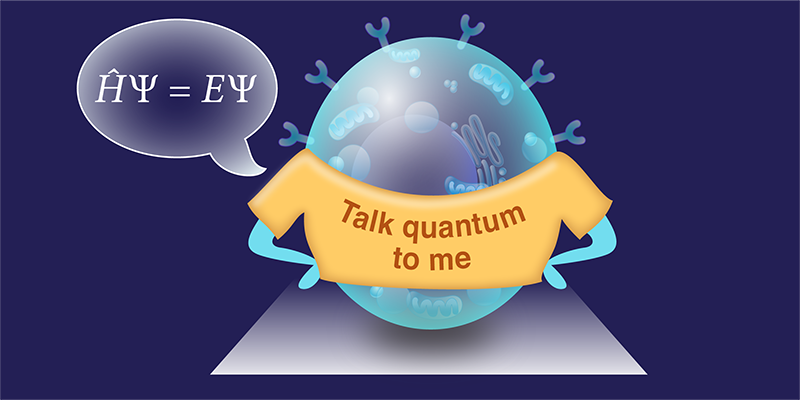It’s Time to Take Quantum Biology Research Seriously
Imagine healing an injury by applying a tailored magnetic field to a wound. This outcome might sound fantastical, but researchers have shown that cell proliferation and wound healing, among other important biological functions, can be controlled by magnetic fields with strengths on the order of those produced by cell phones. This kind of physiological response is consistent with one caused by quantum effects in electron spin-dependent chemical reactions. However (and it’s a big however), while researchers have unambiguously established such reactions for in vitro experiments, they have not done so for in vivo studies. The barriers to in vivo experiments stem both from the absence of experimental infrastructure to perform true quantum measurements inside biological systems and from a misunderstanding of what quantum behaviors in biology are and why they matter. In my opinion, it is time to set the record straight so that we can legitimize work in this field. Quantum biology findings could enable the development of new drugs and of noninvasive therapeutic devices to heal the human body, as well as provide an opportunity to learn how nature builds its own quantum technologies.
Quantum biology researchers study the inherent quantum degrees of freedom of biological matter with the goal of understanding and controlling these phenomena. To a physicist, I’d describe quantum biology as the study of light–matter interactions, where the matter is living. Quantum biology is not the study of classical biology using quantum tools, nor is it the application of quantum computers or of quantum machine learning to drug discovery or healthcare big data processing, and it definitely has nothing to do with the manipulation of free will, with the origin of consciousness, or with other New Age buzzwords.
Experimental evidence consistent with quantum effects existing in biological systems has been around for more than 50 years. One example is the spin-dependent chemical reaction thought to allow birds to navigate using Earth’s weak magnetic field. Today, there is no doubt that such phenomena play important roles in laboratory biological systems—for example, it is uncontroversial that quantum superpositions can manifest in proteins in solution for long enough that they influence chemical processes. But as yet there is no unambiguous experimental evidence that a single living cell can maintain or utilize quantum superposition states within its molecules, as is required, for example, if birds truly use a quantum process as a compass.
This lack of experimental verification is one of the main reasons that the field is considered inconsequential by funders and by the established quantum and biophysics communities. Yes, sophisticated experiments have been performed with single molecules in solution and with whole organisms (birds and flies, for example). But these experiments only show correlation, not causation, between a molecule’s or an organism’s behavior and quantum physics. Bridging that gap will require performing truly quantum measurements inside biological matter using challenging combinations of quantum instrumentation and wet lab techniques.
Another reason quantum biology is not considered a legitimate field of science is the absence of a cohesive quantum biology community. That deficit is beginning to change, but further efforts are needed in that direction. In early 2020, people in my lab and in the Quantum Biology Doctoral Training Centre at the University of Surrey, UK, started an online seminar series called Big Quantum Biology Meetings. The seminars provide a forum for the more than 600 quantum biology researchers and enthusiasts signed up to our mailing list to meet informally once a week. Other efforts to create a cohesive community include establishing a Gordon Research Conference on Quantum Biology, the first of which happened earlier this year and was attended by 150 people, and the gaining of support from the National Science Foundation for a Research Coordination Network on “Instrumentation for Quantum Biology.”
A point of pride of the Big Quantum Biology Meetings series is the intentional incorporation of inclusive practices in the seminars. For example, each meeting starts with a short presentation from a trainee, which we define as anyone without a permanent position, giving them and their work exposure. The trainee is then the host and mediator for the rest of the meeting. The main speaker also gives a “DEIJ moment”—one slide on anything related to diversity, equity, inclusion, and justice that has impacted their scientific life.
A final reason why quantum biology struggles in being accepted as a stand-alone field is the continued presence of scientific silos at institutions. If cells and organisms are using quantum effects to function optimally, a cohort of interdisciplinary experts is needed to collaboratively explore the problem. In my opinion, this collaboration would ideally take place in a quantum biology-focused institute where scientists can easily and organically work together. Recently, in an example of this idea, Japan unveiled the Institute for Quantum Life Science, which brings chemists, biologists, engineers, clinicians, physicists, and others under one roof to work on quantum biology research questions. The development of a similar institute in the US could help in irrevocably establishing this field—which will have, I believe, radical consequences for the biological, medical, and physical sciences.





